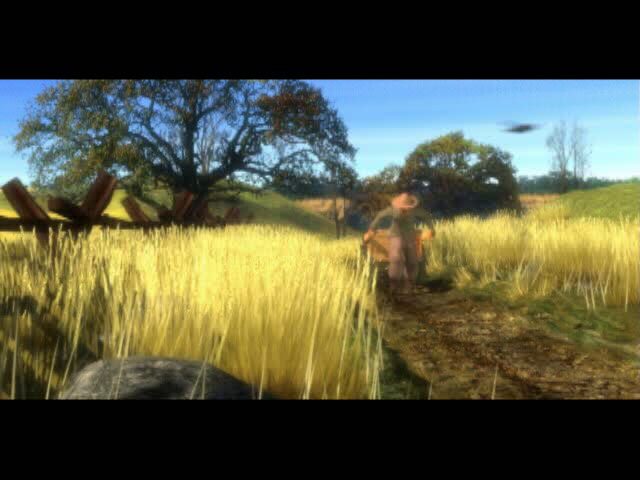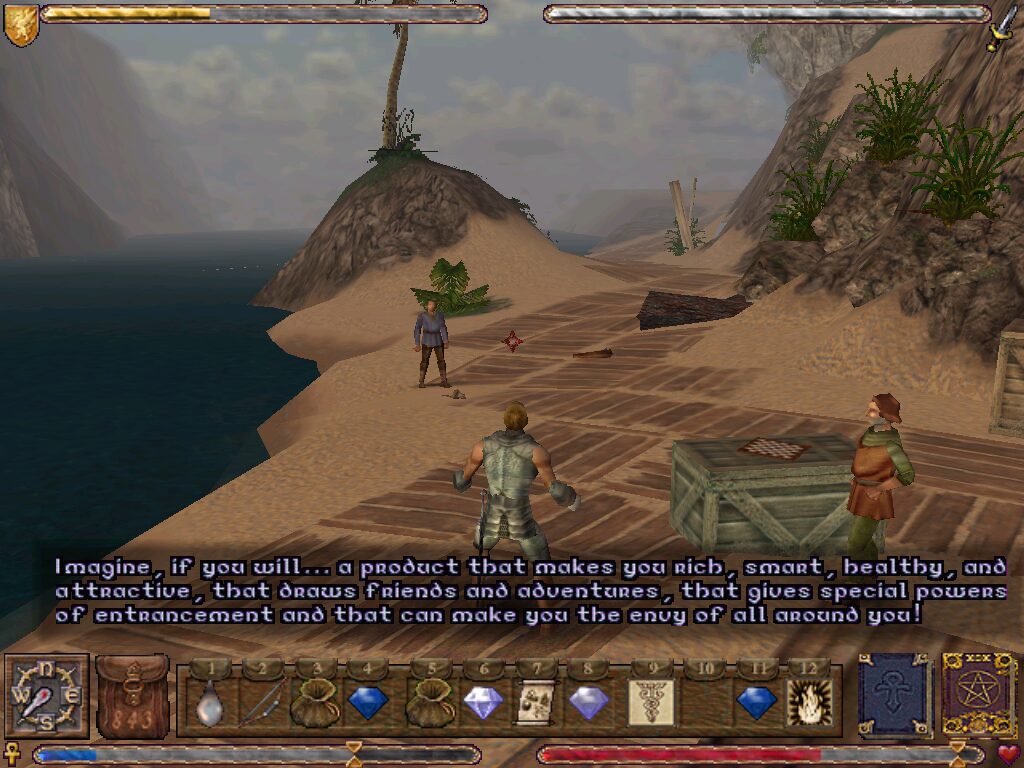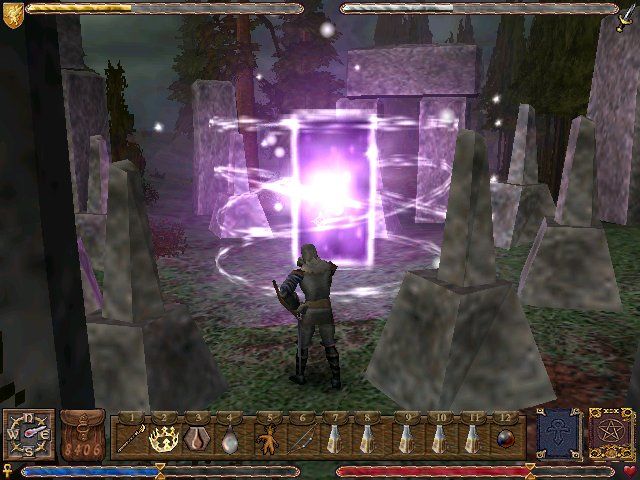Retro Replay Review
Gameplay
Ultima IX: Ascension delivers a unique blend of action-adventure and traditional role-playing elements, placing the Avatar once again at the heart of Britannia’s struggle against the Guardian’s curse. Unlike previous installments in the series, there is no conventional experience point system; instead, your attributes grow as you conquer major story milestones and cleanse the eight Shrines of Virtue. This design choice places a strong emphasis on narrative progression, ensuring that each victory over a shrine’s dungeon is both mechanically and thematically rewarding.
(HEY YOU!! We hope you enjoy! We try not to run ads. So basically, this is a very expensive hobby running this site. Please consider joining us for updates, forums, and more. Network w/ us to make some cash or friends while retro gaming, and you can win some free retro games for posting. Okay, carry on 👍)
Combat in Ascension is entirely real-time and heavily leans toward an action-oriented feel. Whether you’re swinging swords, loosing arrows, or casting powerful spells, battles require quick reflexes and careful positioning. The absence of AI-controlled companions forces the Avatar to face most threats alone, heightening the tension in each skirmish. While purists of turn-based RPG combat may miss more tactical depth, fans of the Zelda-like approach will appreciate the fluidity and immediacy of each encounter.
Dungeon design emphasizes puzzles and environmental interaction as much as it does monsters. Many Shrine complexes include hidden levers, moving blocks, and pressure-plate challenges that recall the best moments of earlier adventure titles. Meanwhile, the physics engine allows you to pick up nearly every object, stack crates to reach ledges, or even use barrels as improvised weapons. This level of interactivity adds a welcome layer of emergent gameplay, encouraging experimentation and rewarding careful observation of your surroundings.
Inventory management and equipment customization remain staples of the Ultima series. You’ll juggle weapons, armor pieces, magical reagents, and quest items in a grid-based backpack, carefully deciding which gear to carry into each dungeon. The game’s financial system also returns, requiring you to buy and repair equipment, pay for lodging, and manage your gold reserves sensibly. These classic RPG trappings add strategic considerations to your exploration, ensuring that resource planning is as important as combat prowess.
Graphics
For its time, Ultima IX: Ascension boasted one of the most advanced 3D engines in the RPG genre. The fully realized world of Britannia is rendered with dynamic lighting, carefully detailed textures, and a draw distance that lets you glimpse distant towers and forests from mountaintop vantage points. Each region—from the haunted ruins of Lord British’s castle to the misty shores of Serpent’s Isle—carries its own visual identity, making exploration a feast for the eyes.
Character models exhibit more complexity than previous Ultima titles, featuring facial animations during cutscenes and varied clothing options that reflect your equipment choices. While some animations may appear stiff by today’s standards, the overall presentation remains impressive. The EAX-supported soundscape complements the graphics, with ambient effects such as wind rustling through trees, dripping water in caverns, and distant monster cries enhancing immersion.
Water effects are particularly noteworthy: reflective surfaces ripple as the Avatar swims or dives, and shallow streams realistically slow your movement, adding tactical considerations to river crossings. Even smaller touches—like torches flickering against dungeon walls or shadows cast by your raised shield—underscore the development team’s commitment to creating a living, breathing world.
That said, the game is not without graphical flaws. Occasional texture pop-in, clipping issues inside cramped dungeon corridors, and rough edges on character models can break immersion. Some players may also encounter performance drops on older hardware, especially when multiple spell effects or combat animations occur simultaneously. Despite these shortcomings, the overall visual fidelity largely stands the test of time for a late-1990s release.
Story
As the final chapter in the Ultima saga, Ascension carries the weight of centuries of lore and expectation. The Guardian’s curse has sullied Britannia’s eight Shrines of Virtue, pulling the glyphs from their protective columns and burying them deep beneath menacing dungeons. With the land’s virtues vanishing from its people, the Avatar must not only face fearsome creatures but also wrestle with his own doubts as trust becomes a rare commodity.
The narrative unfolds through a mix of in-game dialogue, dramatic cutscenes, and environmental storytelling. Key NPCs—both new and returning—offer side quests that flesh out regional histories, local customs, and moral dilemmas. While some plot threads feel hurried or underdeveloped, the core quest to restore each virtue resonates with the franchise’s long-standing themes of honor, compassion, and courage.
Ascension’s pacing strikes a balance between grand set pieces and quieter moments of reflection. Whether you’re deciphering a shrine’s ancient runes or negotiating with suspicious villagers, the story maintains a sense of urgency. The climax at the Guardian’s fortress ties together plotlines from earlier Ultima entries, offering fans of the series a bittersweet farewell—even if newcomers may find certain references perplexing without prior knowledge of Britannia’s history.
Voice acting ranges from serviceable to occasionally stiff, yet it rarely detracts from the emotional stakes. Musically, the soundtrack swells at critical junctures, underscoring your victories and amplifying the tension during dungeon crawls. Though the writing can sometimes lean into melodrama, the heartfelt ambition of the story anchors the entire experience.
Overall Experience
Ultima IX: Ascension is an ambitious finale that strives to merge the best aspects of action-adventure and classic role-playing. Its strengths lie in immersive worldbuilding, interactive environments, and a heartfelt narrative that honors over a decade of franchise lore. Cleansing the Shrines of Virtue never feels like a simple fetch quest; each victory carries tangible weight for both the land and its inhabitants.
However, the game’s technical rough edges—such as camera quirks, occasional bugs, and uneven animation quality—can hamper the overall flow. Combat, while engaging, may feel repetitive for those seeking deeper tactical nuance. And the milestone-based progression system may disappoint players used to more granular character development.
For long-time Ultima fans, Ascension delivers emotional closure and memorable set pieces that reward familiarity with Britannia’s history. Newcomers, on the other hand, may appreciate the game as a standalone action-RPG while potentially missing some narrative subtleties. Either way, the title remains a significant part of role-playing game history, offering a bold, if imperfect, vision of a sprawling fantasy world.
In the end, Ultima IX: Ascension presents a compelling, if flawed, swan song for the Avatar’s journey. Its scope and ambition shine through, even when technical limitations threaten to dull the experience. For those willing to forgive occasional stumbles, Britannia’s final chapter will provide hours of exploration, puzzle-solving, and moral reflection—true hallmarks of the Ultima legacy.
 Retro Replay Retro Replay gaming reviews, news, emulation, geek stuff and more!
Retro Replay Retro Replay gaming reviews, news, emulation, geek stuff and more!








Reviews
There are no reviews yet.